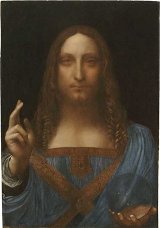Boston.com has a nice article about the Wyeth exhibition at the Farnsworth Art Museum in Rockland, Maine.
Han van Meegeren Strikes Again
 As I mentioned earlier, art theft is relatively rare since it’s extremely difficult to re-sell stolen art. Unfortunately, one type of theft remains prevalent: forgery. The history of art is riddled with stories in which hucksters sold forgeries as original works by master artists. For anyone familiar with this aspect of the art world, the news out of London that a 17th Century painting in the Courtland Institute is actually a 20th Century fake should come as no surprise.
As I mentioned earlier, art theft is relatively rare since it’s extremely difficult to re-sell stolen art. Unfortunately, one type of theft remains prevalent: forgery. The history of art is riddled with stories in which hucksters sold forgeries as original works by master artists. For anyone familiar with this aspect of the art world, the news out of London that a 17th Century painting in the Courtland Institute is actually a 20th Century fake should come as no surprise.
As recently as 2009, it was reported that curators at the Courtland along with ones from the National Gallery thought the painting had “every appearance of being of 17th-century origin.” On one aspect most curators agreed: it was not an original work. The Courtland piece was thought to be a 17th Century anonymous copy of a 1620s brothel scene by Dutch master Dirck van Baburen.
Scientific tests commissioned by the BBC program Fake or Fortune? revealed its actual origins. A detailed examination of the paint determined that it contained a “synthetic resin similar to Bakelite” which is added to mimic age. Consensus now holds that it was the work of the famous 20th Century forger Han van Meegeren.
How Police Nabbed Mark Lugo
New details emerged in the capture of Mark Lugo. The San Francisco gallery owner, Roland Weinstein, told the New York Times one of his employees noticed Lugo as he left the gallery with the Picasso under his arm. She was immediately suspicious because the piece wasn’t wrapped like it would have been after a sale.
The employee followed Lugo onto the street where she saw him get into a cab. “She took down the taxi number, ran back inside, saw that [the Picasso] was gone, and called the police,” Weinstein said.
The San Francisco police quickly tracked down the driver, who said the passenger had mentioned the Hotel Palomar. “Almost immediately, they had video of him from in the cab, from the hotel, and from Lefty O’Doul’s restaurant near us, and they knew his name,” Mr. Weinstein said.
The Weinstein Gallery quickly upgraded security. Gallery owners are often lulled into complacency because art theft is rare. It’s very hard to re-sell stolen art which lowers its theft appeal. In this case, the thief seemed interested in simply building his own collection. If not for the diligence of a gallery employee, Lugo’s stolen art might be laying low on his apartment walls.
Christina’s World
 Christina’s World is an iconic mid-century painting by Andrew Wyeth. In the foreground a slender and attractive woman lies in a barren field some distance from a house on a hill. She is Christina Olson and she was struck by polio when she was younger. That disease was prevalent in rural America during former half of the 20th Century. The landscape in this painting was supplied by rural Maine. Undaunted by muscular paralysis as a result of that disease, Ms Olson moved about with the only means at her disposal: her arms.
Christina’s World is an iconic mid-century painting by Andrew Wyeth. In the foreground a slender and attractive woman lies in a barren field some distance from a house on a hill. She is Christina Olson and she was struck by polio when she was younger. That disease was prevalent in rural America during former half of the 20th Century. The landscape in this painting was supplied by rural Maine. Undaunted by muscular paralysis as a result of that disease, Ms Olson moved about with the only means at her disposal: her arms.
Wyeth owned a vacation home in Maine and he was fond of Ms. Olson. He was inspired to paint Christina’s World when he saw her crawling through a nearby field. He was familiar with both her and her brother – he painted both over the years. For this painting, Wyeth’s wife posed for the torso.
The house in the distance is on the Olson farm in Cushing, Maine. It is open to the public and the tour offers a fascinating depiction of the real world of Christina and her family. On June 30, 2011, the house was named a National Historic Landmark. This summer and fall, there is a rare opportunity to view 50 Wyeths at the Farnsworth Museum in Rockport, Maine.
Picasso Thief Bolstered His Collection In June
 Remember Mark Lugo? He walked into a San Francisco gallery and ran out with a Picasso under his arm. Police found him and the drawing in a San Francisco hotel as he prepared to flee the city.
Remember Mark Lugo? He walked into a San Francisco gallery and ran out with a Picasso under his arm. Police found him and the drawing in a San Francisco hotel as he prepared to flee the city.
It’s said that there’s no such thing as bad publicity but Mark Lugo may take issue with that assertion. In the wake of news reports of West Coast heist, police on the East Coast were able to match Lugo’s image from San Francisco surveillance footage with that of the thief who stole a $350,000.00 Picasso from the Carlyse Hotel. Lugo is now the prime suspect in several art heists.
In June 2011, Lugo appears to have been on a quest to bolster his art collection. Unlike many collectors, he left his Amex card at home. When police raided his Hoboken apartment, they unearthed a trove of art whose value was estimated at half a million dollars. Lugo was a New York sommelier.
In total, eleven works were recovered. Five were reported stolen from New York galleries and the remaining six were stolen from hotels. Lugo was drawn toward modern and contemporary work. The Bay Citizen has details:
Police found a Richard Pugliese painting from the Harris Gallery, five small Mie Yim drawings from the Chambers Hotel, a Nara Yoshitomo from the Opera Gallery, a Jean-Michel Basquiat photo from the Scot Foreman Gallery, the Leger sketch from the Carlyle Hotel, a Malick Sidibe photograph from the Jack Shainman Gallery and another Pablo Picasso sketch from the William Bennett Gallery.
East Coast police are still compiling the case against Lugo. Meanwhile in San Francisco, he faces an array of felony counts, among them grand theft, possession of stolen goods and commercial burglary. While he may have been caught on surveillance with the Picasso under his arm and later red-handed with the drawing in his hotel room, Mark Lugo plans to plead 100% not guilty.
The Physics of Jackson Pollock
A physicist, a mathematician and an art historian have produced what they feel is the first quantitative analysis of Jackson Pollock.
“His particular painting technique essentially lets physics be a player in the creative process,” said physicist Andrzej Herczynski of Boston College, coauthor of a new paper in Physics Today that analyzes the physics in Pollock’s art. “To the degree that he lets physics take a role in the painting process, he is inviting physics to be a coauthor of his pieces.”
Pollock’s unique technique — letting paint drip and splatter on the floor rather than spreading it on a vertical canvas — revolutionized the art world in the 1940s. The resulting streaks and blobs look haphazard, but art historians and, more recently, physicists argue they’re anything but. Some have suggested that the snarls of paint have lasting appeal because they reflect fractal geometry that shows up in clouds and coast lines.
Lost Work by Leonardo da Vinci
 In the world of Italian Renaissance art, one name stands out: Leonardo da Vinci. With the possible exception of Michelangelo, no other artist from the period continues to capture the public’s imagination. His Mona Lisa is among the biggest attractions in the Louvre. In 1962, the painting was assessed at $100 million dollars. In today’s pricing, that would be close to three-quarters of a billion dollars.
In the world of Italian Renaissance art, one name stands out: Leonardo da Vinci. With the possible exception of Michelangelo, no other artist from the period continues to capture the public’s imagination. His Mona Lisa is among the biggest attractions in the Louvre. In 1962, the painting was assessed at $100 million dollars. In today’s pricing, that would be close to three-quarters of a billion dollars.
Because Leonardo holds such a firm grasp on the public’s imagination, few notions create more buzz than the reappearance of a lost work. This autumn the National Gallery in London will display a rediscovered painting, titled Salvator Mundi, which it will label “Leonardo da Vinci.” The exhibition opens November 9th, but the news was made public this week by the owners of the portrait.
The painting is now owned by a US consortium of art dealers but it was once in royal hands. Salvator Mundi was earlier owned by Charles I, who ascended to the thrown more than a century after Leonardo’s death. In 1900, it was purchased by Sir Frederick Cook whose descendants sold it in 1958 for just $72.00.
Last year a group of conservators who were handling the painting for the Hermitage Museum in St Petersburg determined it was created by Leonardo Da Vinci. As a result of that assessment, the $72.00 painting is now worth close to $200 million dollars.
Read more:
[Leonardo da Vinci: Wikipedia] [The Independent] [The Guardian]
Art Links: Crazy Edition
A Man Named Guy
 Daniel Wildenstein has been dead for ten years but the battle over his fortune continues.
Daniel Wildenstein has been dead for ten years but the battle over his fortune continues.
Wildenstein headed Wildenstein and Company, a large conglomerate of galleries in locations throughout the world. He was a noted scholar who compiled the catalogues raisonnés of many noted impressionists. Works by artists such as Monet, Manet and Gauguin are often referred to by their Wildenstein index number. When he died in 2001 after complications from surgery, his immense fortune went to his sons Alec (now deceased) and Guy along with his widow Sylvia Roth.
After her husband died, Sylvia began to accuse the sons of hiding Wildenstein wealth in order to cheat her out of her inheritance and to evade taxes. Sylvia Roth died last November but the lawsuit refused to die with her. In accordance to her wishes, he lawyer continues to pursue the case.
While investigating the Roth lawsuit, a French anti-fraud unit searched a Wildenstein warehouse. What they found shocked them. Inside a storeroom in the non-profit Wildenstein Institute, they found thirty paintings that were reported stolen over the years. Many of the pieces were reported stolen by Jewish families whose art was seized by the Nazis.
As a result of this find, French authorities have charged Guy Wildenstein concealment and breach of trust. When questioned about the pieces last April, Wildenstein told authorities they must have been an oversight error. Three months later, it appears that excuse failed to appease them.
Picasso Theft In San Francisco
![]() A New Jersey man walked into a San Francisco art gallery and left with a $200,000.00 Picasso pencil drawing. There was one little problem with the transaction: he never paid. Mark Lugo of Hoboken, NJ, grabbed “Tete de Femme” from the Weinstein Gallery wall and fled on foot. A surveillance camera captured him as he fled down the street with a framed Picasso under his arm.
A New Jersey man walked into a San Francisco art gallery and left with a $200,000.00 Picasso pencil drawing. There was one little problem with the transaction: he never paid. Mark Lugo of Hoboken, NJ, grabbed “Tete de Femme” from the Weinstein Gallery wall and fled on foot. A surveillance camera captured him as he fled down the street with a framed Picasso under his arm.
It was a stroke of luck that Lugo was able to easily remove the art. The Weinstein Gallery hangs works with multiple hooks, one on the top and one on the bottom. If someone tries to pull a piece off the wall, the top hook should pull back. In this case, the top hook was loose. When Lugo tugged at the Picasso, the top hook yanked out of the wall.
As he fled, Lugo conveniently stumbled across a cab. He flagged it and hired a ride to a hotel near Fourth and Market streets. Inside the Hotel Palomar, he packaged the Picasso piece for shipping. Although he was working alone, Lugo appears to have had a buyer lined up. Police were able to locate the cab driver who led them to the Palomer. Inside they found Lugo and the Picasso which was undamaged in the incident.
Lugo is in police custody and bail was set at $5 million.
Main Menu
Site Info